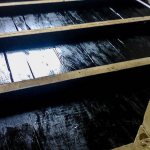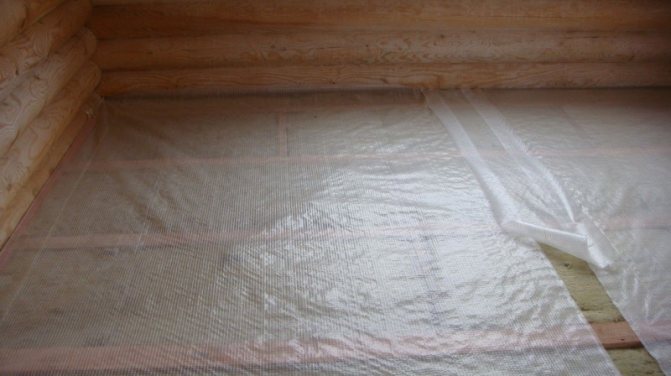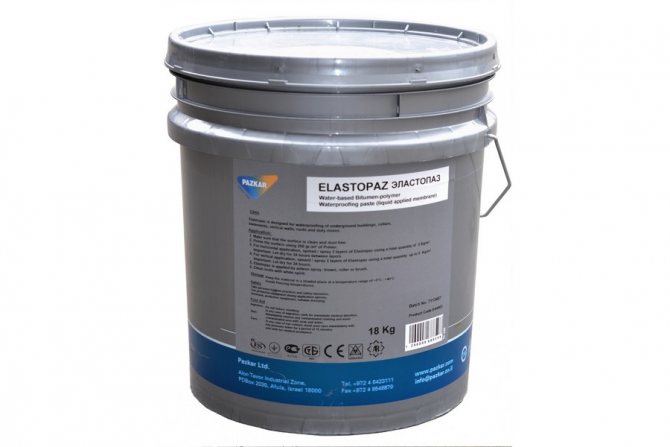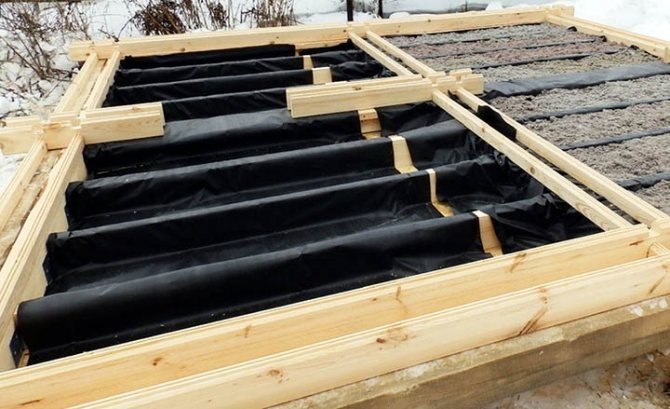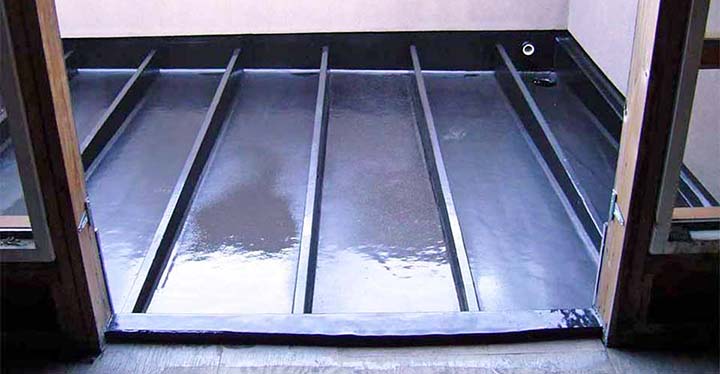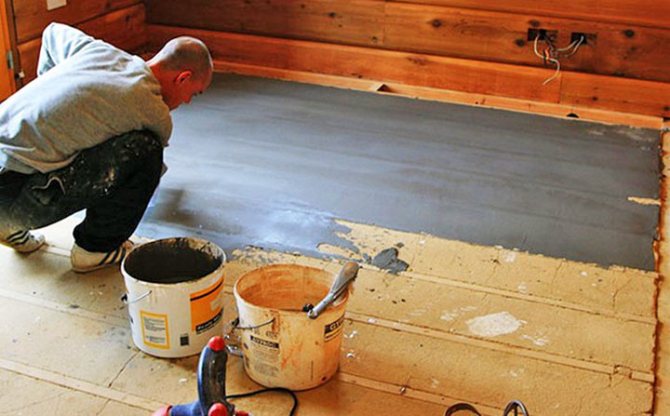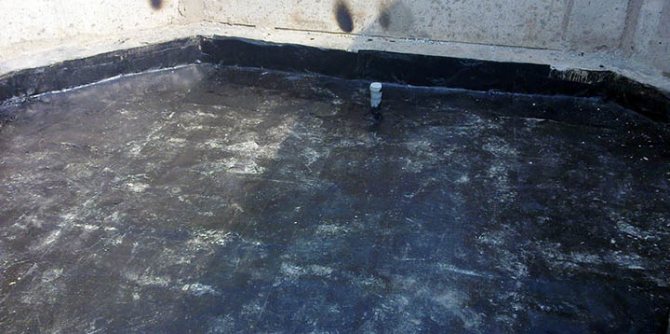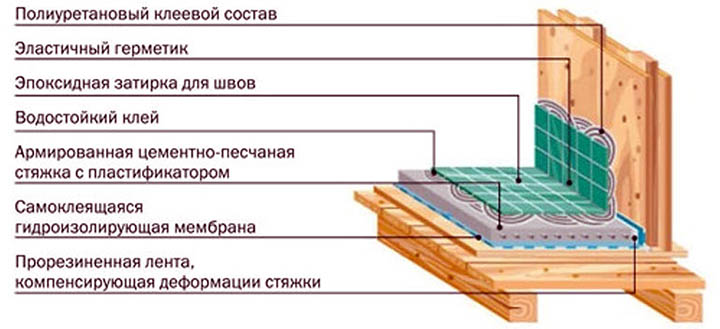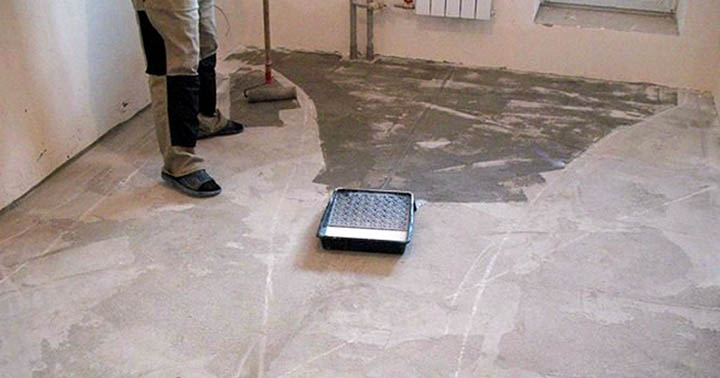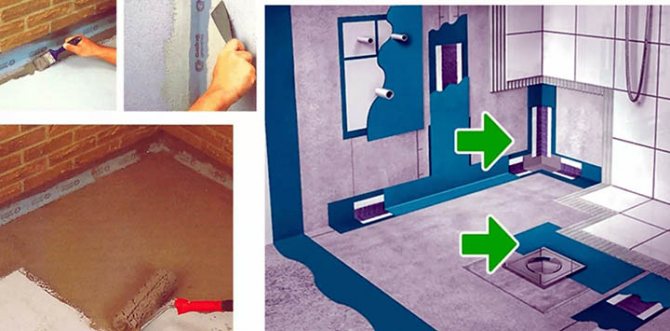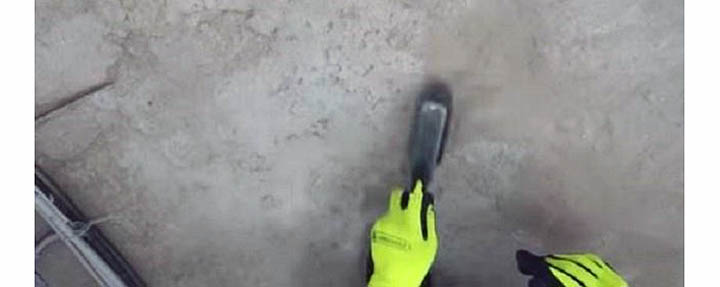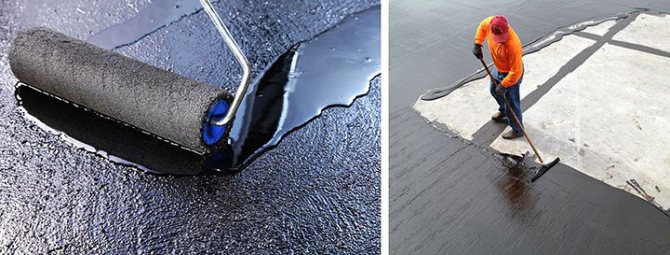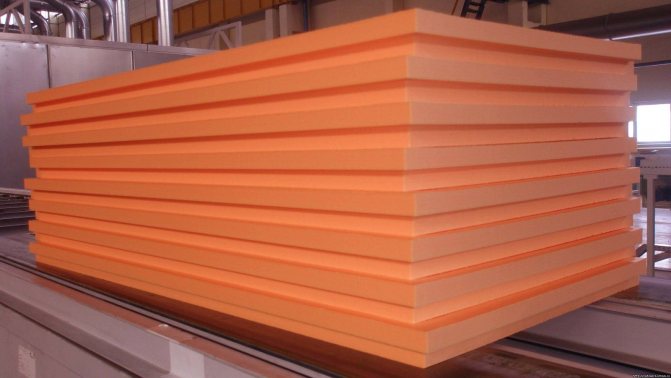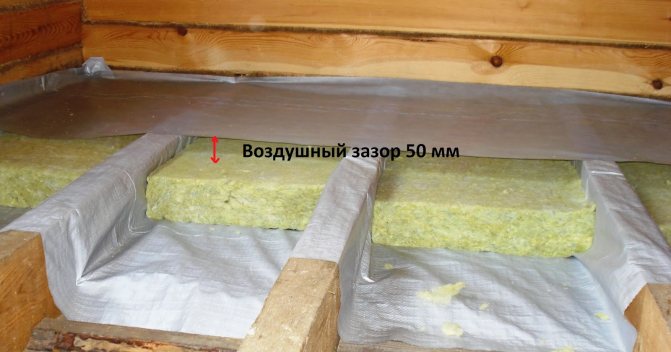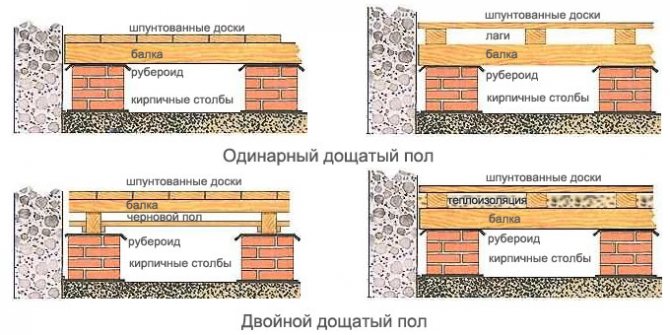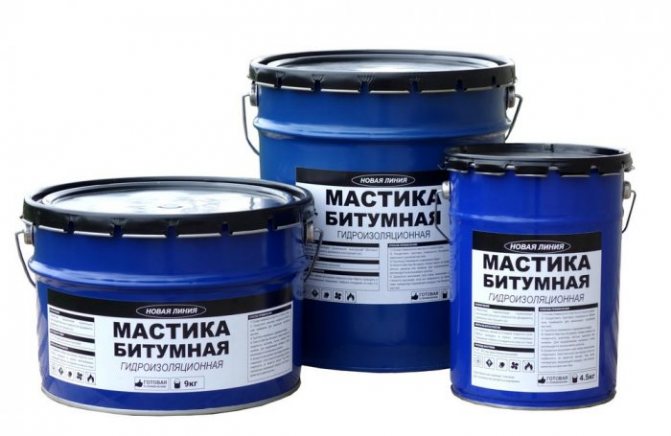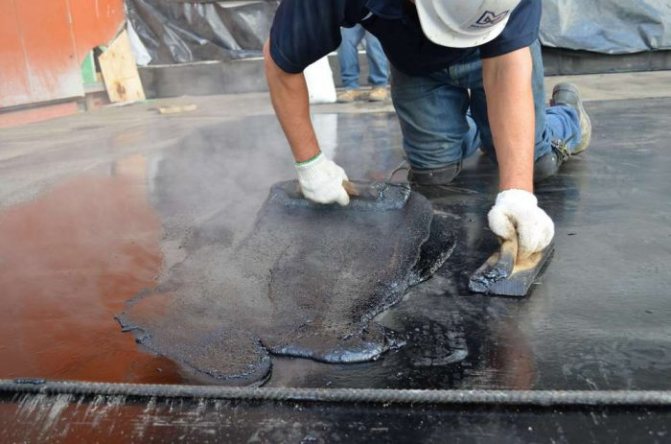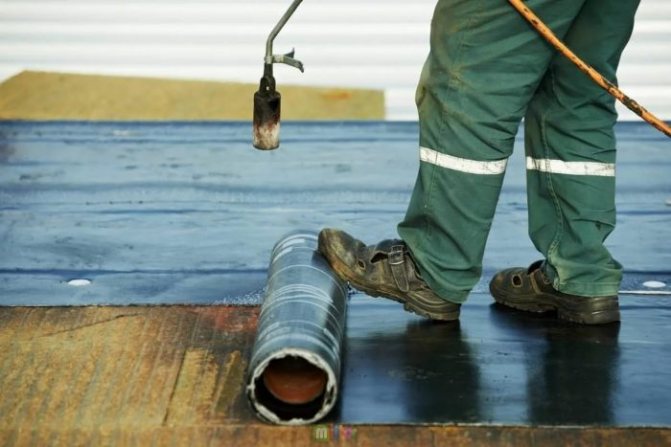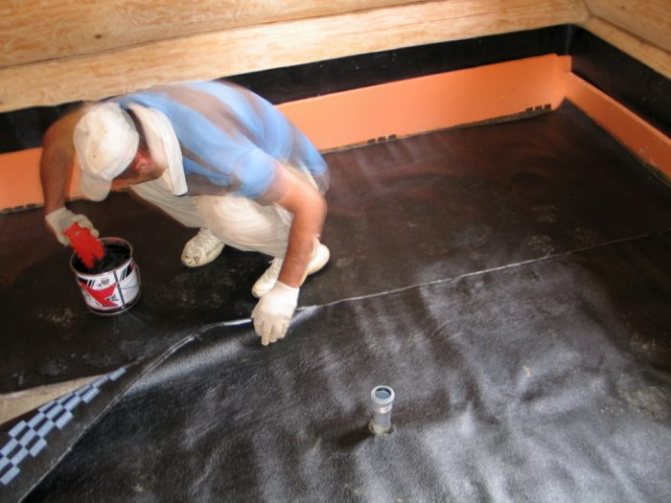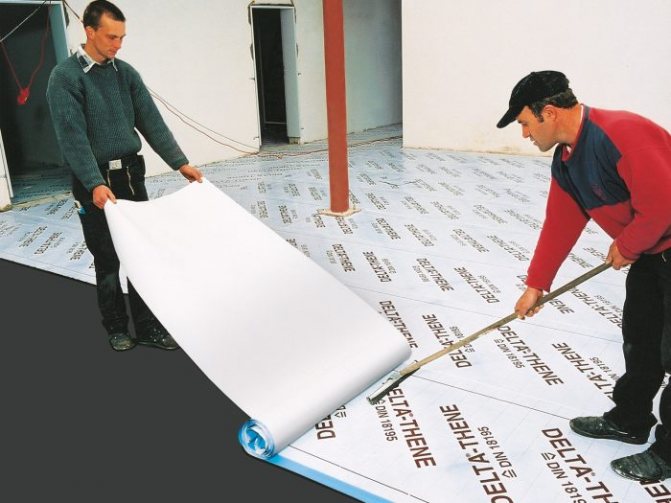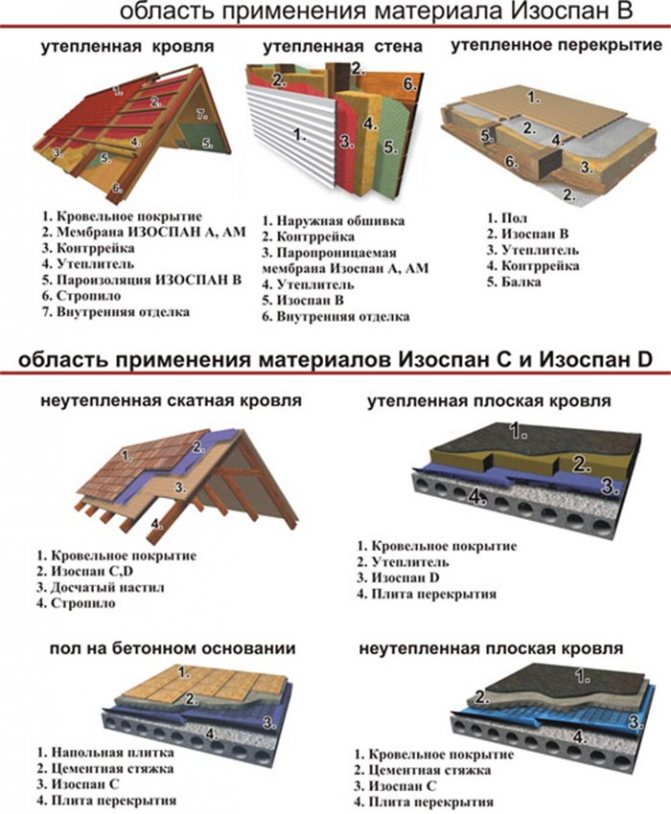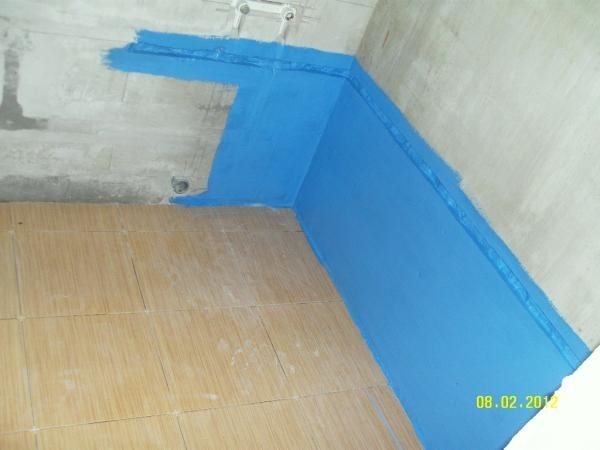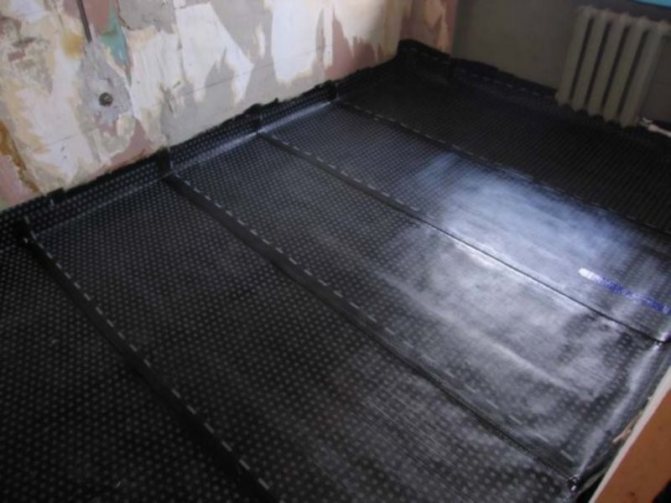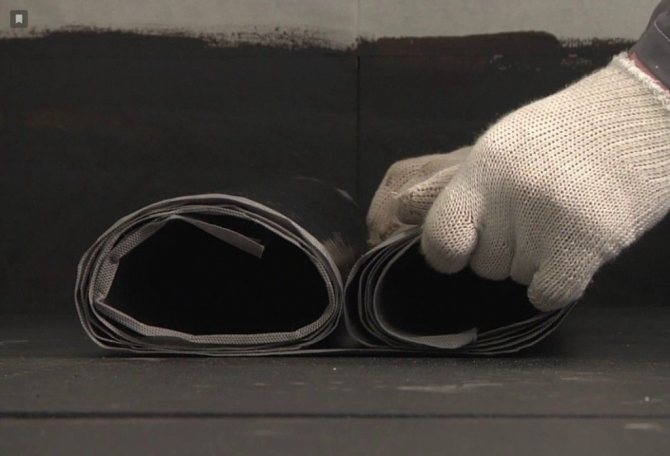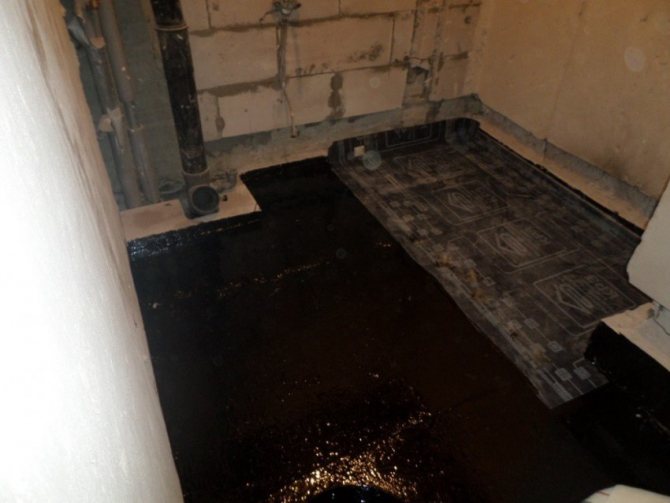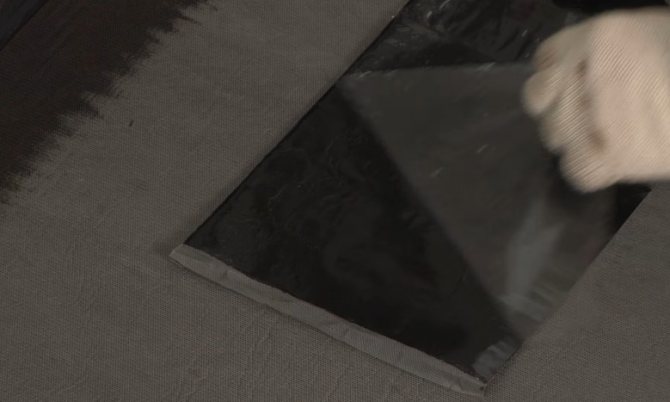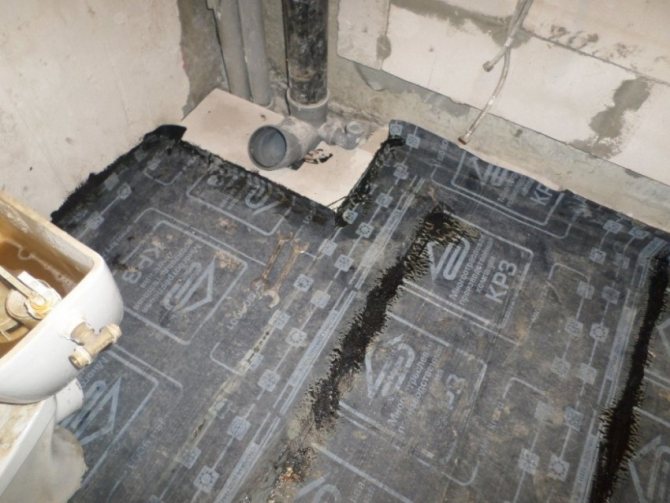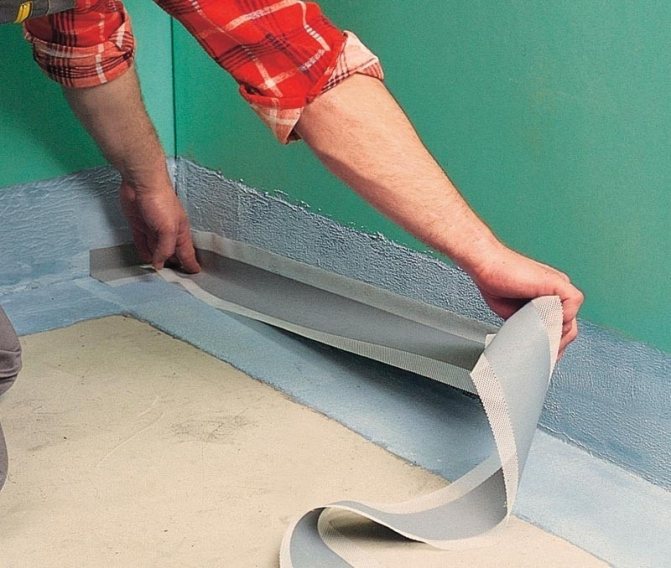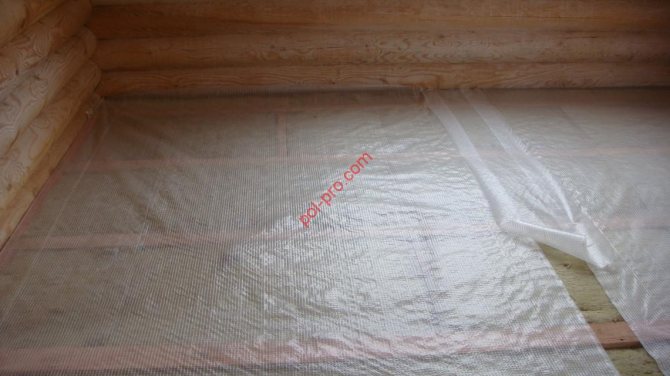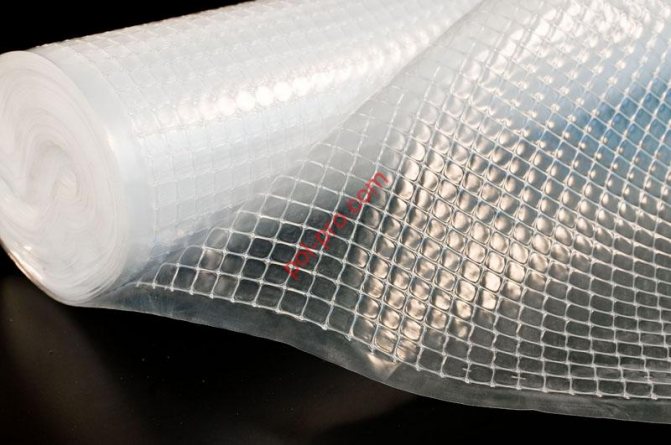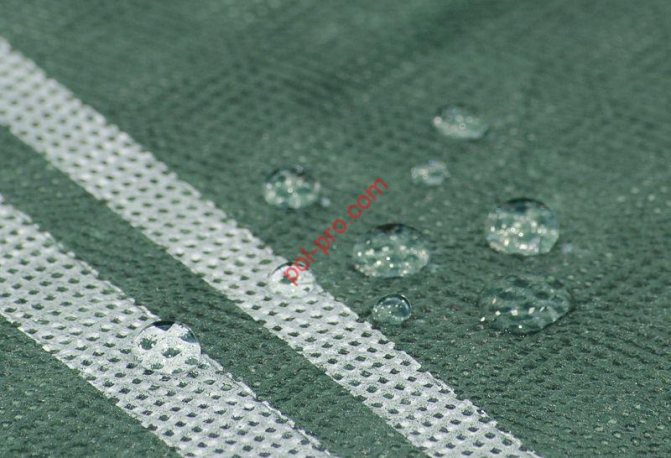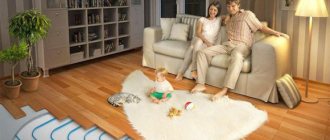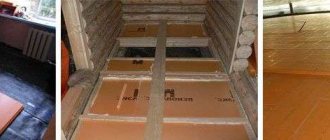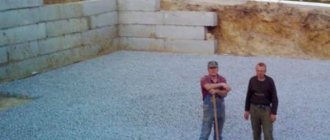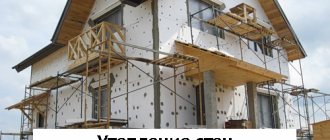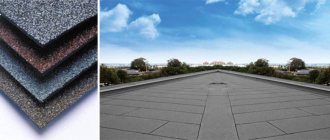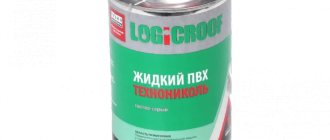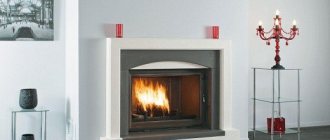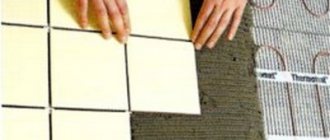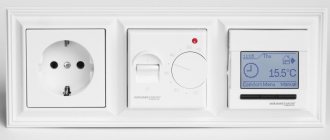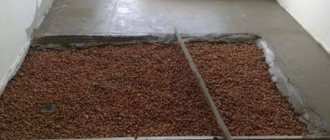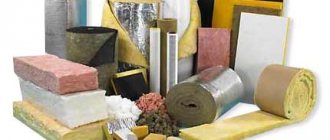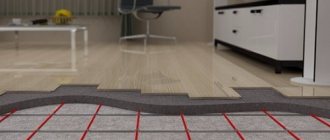Waterproofing wooden floor
The main stage in the arrangement of a wooden house is considered to be the protection of the floor from water. Material that has not been properly processed, with regular exposure to moisture, begins to swell, and mold and fungal lesions form on its surface. They pose a health hazard to residents. That is why it is necessary to approach isolation with great responsibility.
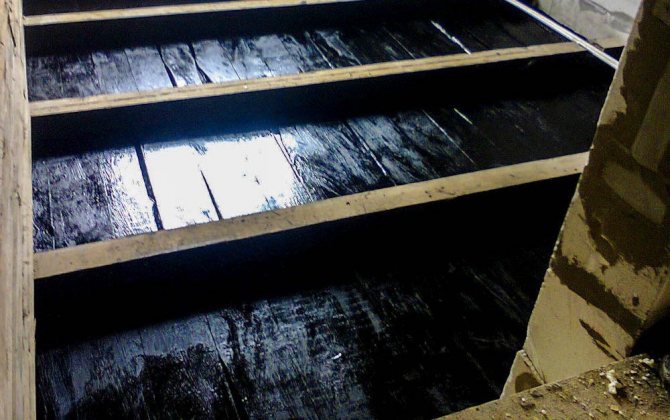
New technologies have made it possible to develop several options for waterproofing. They differ not only in price, but also in their features, technical data. To select a suitable insulation method, it is necessary to take into account the type of room, the main finish and other features.
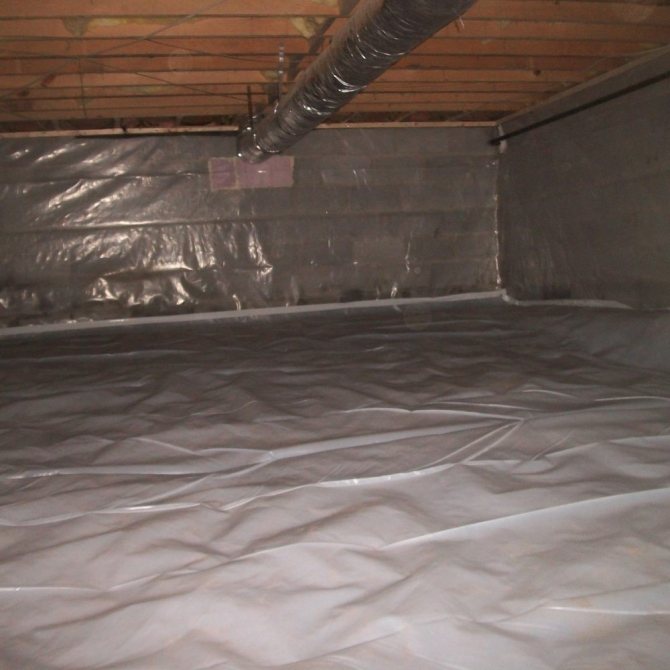

Applied materials for vapor barrier
The following materials are used for the device of vapor barrier layers:
Various roll films:
- polyethylene;
- polypropylene;
- with a reflective layer (food grade aluminum foil);
- reinforced and unreinforced.
Ventilation gap is required. Films are fragile, so they must be laid very carefully so as not to tear.
Diffuse membranes:
- one-sided, allowing air to pass through only on one side;
- double-sided;
- single or multi-layer;
- with anti-condensation layer.
Ventilation gap is optional. These are the highest quality, but expensive vapor insulators.
It's up to you which vapor barrier to choose for your floor, but savings can lead to unforeseen costs.
A well-made vapor barrier will ensure the durability of the floor and will help maintain a comfortable climate in a wooden house.
- External finishing
Why waterproof a wooden floor
Do not ignore the need to waterproof your wooden floor. This is especially true for wet rooms and buildings located in regions with high humidity. This will save not only time, but also finances for permanent repairs or replacement of floor parts.
But floor waterproofing may not always be required. It is required in the following cases:
Kitchen and bathroom
... In these premises there is a water supply and sewerage system. Even with the use of modern materials, the likelihood of an emergency remains. The consequences of pipe breaks are always significant. There is a risk of spoiling not only the finish of the bath or kitchen, but also the neighboring rooms. Neighbors living on the floor below also suffer from the flood. Waterproofing will not completely prevent leakage, but significantly reduce the volume of water and minimize the consequences of an accident. Thus, timely waterproofing will save financial resources, and repairing plumbing and eliminating the consequences of an accident does not cost little money.
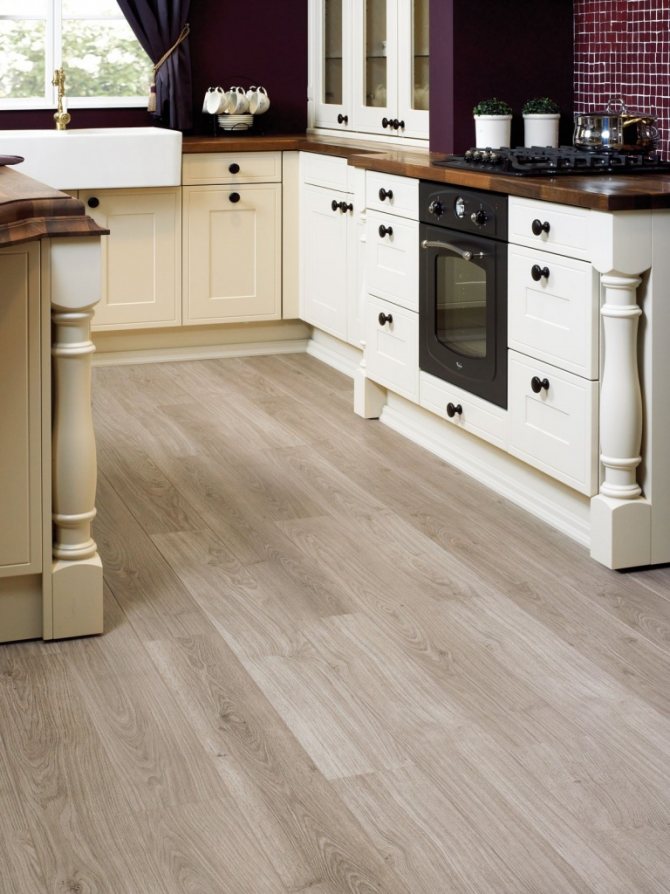

Premises
located in high-rise buildings. In this case, it is not intended for permanent protection, but is used only to prevent flooding of neighbors when pouring the floor. This does not require capital insulation. It is enough to use ordinary plastic wrap.
Private houses
... The floor, regardless of whether the house is on a strip foundation or piles, contacts the ground to varying degrees. To prevent the ingress of moisture from the soil, waterproofing is applied. Its absence leads to damage not only to the rough coating, but also to the main one. In a short time, the tree becomes covered with mold, begins to rot, decay. After a few years, expensive and complex repairs will be required.
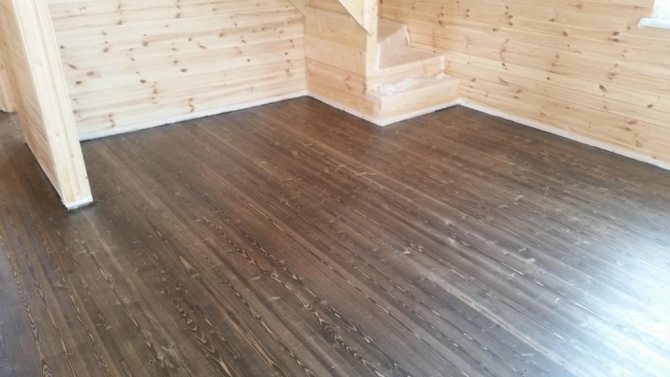

In all of the above cases, it is imperative to waterproof the floor. This will save money and time in the future.
How to make a vapor barrier for the floor in a wooden house correctly?
One of the main indicators that determine comfortable living conditions is the level of humidity. Building elements are susceptible to increased moisture concentration and require special protection methods. The floor, which is a multi-layer structure, is no exception. Professionally made vapor barrier for the floor in a wooden house allows to ensure the protection of heat-insulating materials and wood from the influence of steam, prolongs the service life of the building. Let's dwell on the materials used, as well as the technology for their installation.
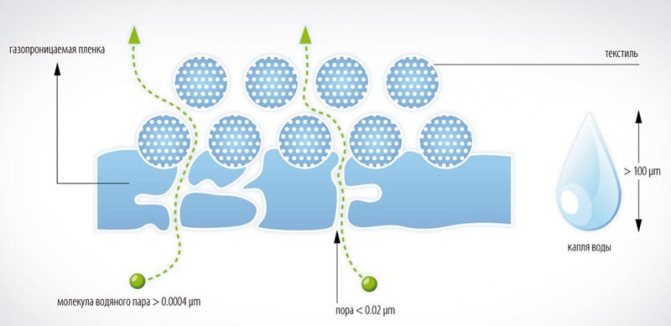

What is the vapor barrier for the floor for?
As a result of the vital activity of people living in the room, increased humidity occurs. It has a negative effect on wood. After all, the condensate formed on the surface over time destroys the thermal insulation coatings. The influence of negative factors, along with walls and ceilings, is also subject to a multi-layer floor in rooms for various purposes:
- living rooms;
- kitchens and bathrooms;
- saunas and baths.
The installation of a vapor barrier in buildings in which the floor of the lower floor is made of soil is especially relevant. The wood and insulation in these buildings are exposed to intense moisture from both sides of the wooden base.
To create a comfortable microclimate, as well as to ensure normal air circulation, the floors are insulated, vapor barrier is installed in this case, without fail. It provides:
- the safety of the heat insulator located in the multilayer structure;
- unimpeded exit of steam generated in the room;
- favorable operating conditions to prevent the formation of mold and mildew;
- effective circulation of humid air.
Many heat-insulating materials, when absorbing moisture, impair the heat-shielding properties. For example, in hygroscopic mineral wool, the thermal conductivity increases up to 30% with its gradual saturation with moisture, which negatively affects the retention of heat in the room.
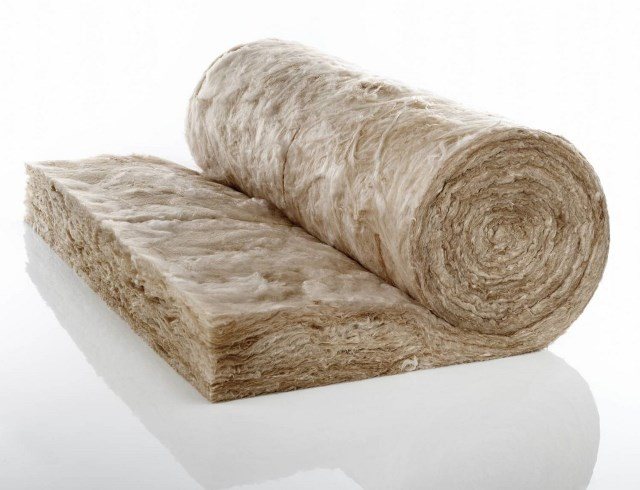

When thinking about how to lay a vapor barrier on the floor, remember that its main task is to ensure the impossibility of access of humid air to floor structures made of wood. That is why the vapor barrier layer is laid between the finished floor and the insulation. It provides:
- increased service life of the floor and other wooden structures of the building;
- a level of humidity in the room favorable for the life of people;
- long-term preservation of the thermal insulation characteristics and properties of the insulation;
- protection of floor beams, which are made of wood susceptible to moisture.
In some cases, the floor slab is equipped with an additional vapor barrier. It complicates the destruction of the insulation by moisture penetrating from the outside. In the absence of a vapor barrier, the destruction of wooden structures will inevitably occur and the heat insulator will prematurely lose its operational properties.
Insulation of floors and vapor barrier - design features
The main feature of the construction of the insulated floor is the correct arrangement of layers, each of which performs certain functions:
- Finish coating. It is laid on a previously prepared surface, decorating elements of a multi-layer base, and provides a high aesthetic perception. Laminate, linoleum, parquet, ceramic tiles, as well as other types of coatings are used as a finishing coating.
- Special backing. It spreads over the boards.Elastic cork, polystyrene or polyethylene material well smoothes local irregularities of the wooden base, providing a reliable barrier against the penetration of extraneous noise into the room.
- Plank base. It is formed from tightly fitted planks nailed to transversely installed joists. The wood is subjected to preliminary antiseptic treatment, which increases its durability. The solid wood surface is capable of withstanding significant loads.
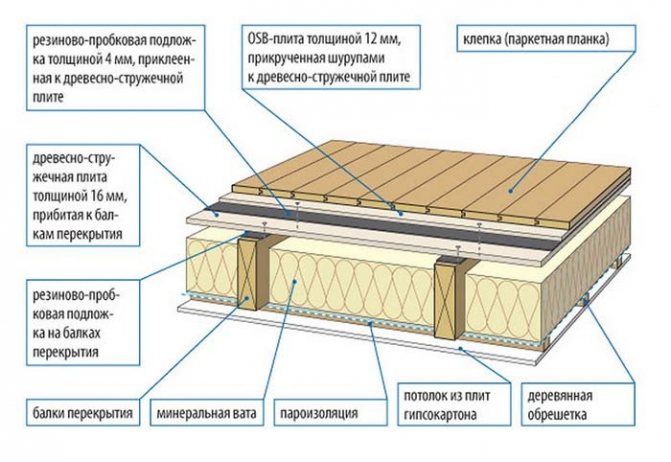

- Counterrails. They are strips that provide a guaranteed gap between the lower surface of the plank floor and the vapor barrier located under it. Forms a ventilated space that promotes efficient air exchange.
- Vapor barrier. This is a special film material, membrane or foil layer, which is fixed to the lags, providing protection to the insulation. The presence of a ventilated gap is a prerequisite for the effective functioning of the vapor barrier.
- Insulation. Polyurethane foam heat insulator, mineral wool or foam sheets are used. These materials are located between the logs, effectively prevent heat loss from the room, and have a reduced degree of thermal conductivity.
- Waterproofing. A special interlayer is made of a waterproof film. It is installed to protect the heat insulator from moisture penetration from the soil. Located above the surface of the subfloor, attached to the logs with special brackets.
When thinking about how to correctly put the vapor barrier on the floor, and where the insulation should be placed, adhere to the given order of the layers and follow the proven installation diagram. This will allow you to avoid unforeseen mistakes and will serve as a guide when performing work.
What materials are used for vapor barrier for the floor
Various types of materials can be used to provide vapor barrier protection for a wooden base:
- polyethylene films. Various types of polyethylene protection are offered, which are distinguished by the presence or absence of perforation. Perforated polyethylene is used for waterproofing purposes, and non-perforated polyethylene is used for vapor barrier. The film has microscopic holes and is characterized by increased vapor permeability;
- reflective films. They are a type of conventional polyethylene vapor barrier with a thin reflective layer of aluminum foil. They have an increased coefficient of vapor barrier, due to which they are widely used in rooms with a high concentration of moisture. In addition, the aluminum coating contributes to heat retention;
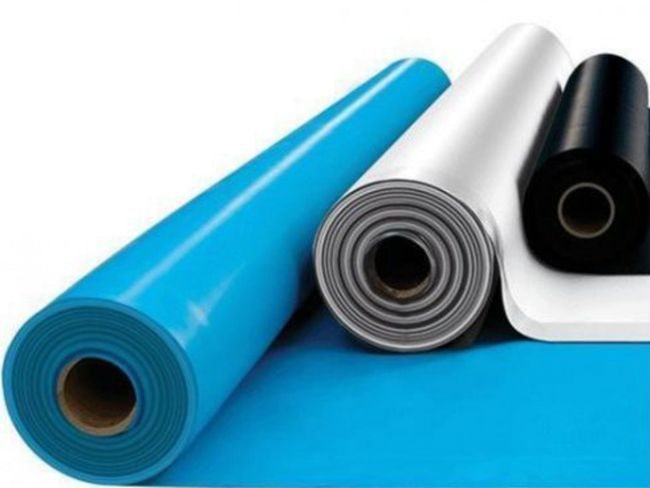

- polypropylene films. A feature of polypropylene protection is the increased strength of the material, which retains its integrity under the influence of natural factors. A special layer may be present on the surface of the film, which is capable of absorbing moisture, making it difficult for condensation to form;
- diffuse membranes. Breathable membrane protection surpasses other types of vapor barrier coatings in quality and efficiency. Membranes are made on the basis of artificial fibers that create a special microstructure. The membrane protection differs in the number of layers. It can pass steam both from one side and in two directions;
- liquid rubber. It is widely used to provide vapor barrier protection. It is a water-based polymer-bitumen mixture. The rubber compound is easy to spray. This creates an elastic and seamless surface. It provides effective waterproofing, creates a thermal barrier and soundproof the room.
Different types of vapor barrier differ in the way they are attached:
- film materials are fixed to the lags.They function effectively only when creating a ventilated space;
- the membrane protection is attached directly to the heat insulator. The membrane performs its assigned functions without a special gap.
Anti-condensation coatings have an increased price. They are distinguished by a multilayer structure and exceed polyethylene films in strength characteristics. The reduced strength of polyethylene vapor barriers is easily eliminated by attaching a special mesh designed for reinforcement.
When deciding on the use of a vapor barrier for floors, pay attention to the following characteristics:
- material strength;
- operational parameters;
- styling features;
- elasticity;
- the degree of vapor permeability;
- the price.
The correct choice of vapor barrier coating ensures the durability of the wood base.
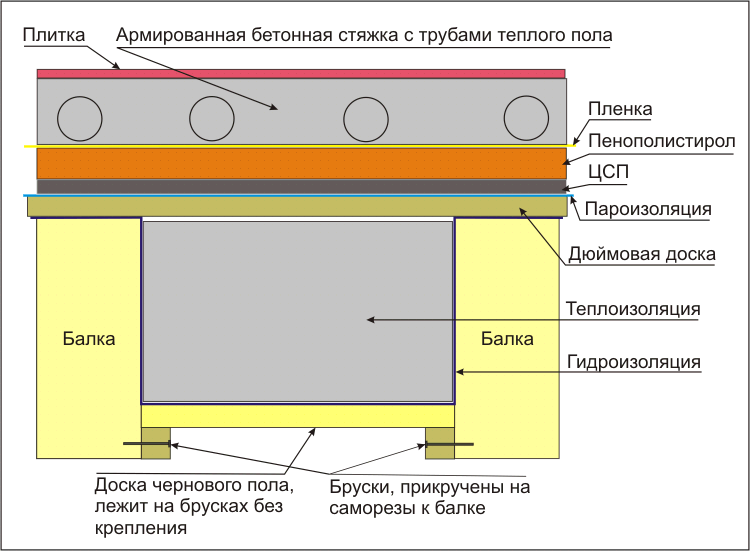

How to properly lay a vapor barrier on the floor in a wooden house - technology of work
To ensure the effectiveness of the vapor barrier, it is necessary to know how to properly lay the vapor barrier on the floor. Understanding which side the moist air comes from, it is easy to determine the mounting features:
- two-layer protection is installed with the smooth side to the heat insulator. In this case, a rough surface, on which moisture condenses, is located towards the room;
- the foil vapor barrier is fixed with the foil side up to prevent heat loss from the room. The canvases are laid end-to-end and connected using a special adhesive tape with a metallized coating;
- polypropylene material with one-sided lamination is located with the smooth side to the insulation. The fibrous base of viscose-cellulose threads is directed in the opposite direction from the heat insulator;
- the polyethylene film performs the functions assigned to it only with a snug fit to the insulation and observance of a ventilated gap of 30–40 mm above it.
It is advisable to carry out measures for the vapor protection of a multilayer floor in a wooden house at the stage of building a building. If at the construction stage a vapor barrier layer was not provided for in the floor structure, then during a major overhaul it can be installed.
Ensuring the desired effect is achieved by observing the technology, which includes two main stages:
- Preliminary surface preparation.
- Laying a vapor barrier layer.
When performing vapor barrier measures at the construction stage, it is necessary to observe the sequence of layers, and perform work according to the following algorithm:
- Assemble the subfloor.
- Mount the supporting beams.
- Lay a waterproofing film.
- Install thermal insulation.
- Fasten vapor barrier material.
- Form a finishing base.
After completing these operations, you can finish with a topcoat.
When restoring a floor that has fallen into disrepair, experts advise performing work in the following order:
- Dismantle dilapidated boards.
- Inspect the log.
- Replace rotten beams, if necessary.
- Treat the wood with an antiseptic.
- Fasten waterproofing.
- Mount insulation.
- Form a vapor barrier layer.
- Anchor the new boards.
Performing operations is not particularly difficult, even in the absence of construction skills. Depending on the applied vapor barrier coatings, slight differences are possible due to the specifics of the fastening of the material or the features of its application to the surface. It is necessary to follow the recommendations of experienced builders and follow the technology.
Is it obligatory to waterproof and vaporize the floor in a wooden house?
After reading the material of the article, doubts about the need to provide vapor barrier protection and the installation of a waterproofing barrier disappear.When installing a multi-layer floor, the implementation of these measures allows you to ensure its long service life and reduce the cost of maintaining a comfortable temperature. Having decided on the material used, having carefully studied the technology, you can independently perform the necessary work. If you have doubts about your own strengths and experience, use the services of professional builders.
Types of suitable waterproofing coatings
The coatings used as waterproofing are varied. Their choice depends not only on the cost, but also on the characteristics of the room, the method of application. But when using any type of insulation, it is important to know that the coating is applied not only to the area of placement of pipes, but also to walls to a height of 20 cm. This is necessary to protect the surrounding structures and finishing from moisture when splashing.
Consequently, the coating should be applied not only to the floor, but also to the walls along the entire perimeter.
Paint shop
Waterproofing a wooden floor can be done with special paints and varnishes. They are considered the most inexpensive and not difficult to use.
The wood can be saved with varnishes based on polymers or bitumen. In addition, they are used to emphasize the structure of wood and create a unique, environmentally friendly interior.
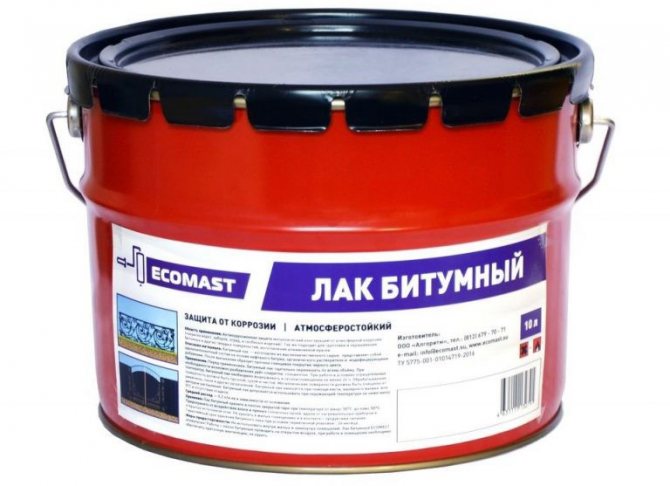

But the disadvantage of this type of insulation is its fragility. Over time, paint or varnish wears off, and the work must be repeated. On average, the service life of the insulation is 3 to 5 years.
Waterproofing the floor in a wooden house is applied only to a leveled and clean surface. For this, a roller or brush is used. Experts recommend painting in two layers. Allow 2-3 days between applications so that the first layer is completely dry.
After work, the room must be ventilated, since the coatings usually have an unpleasant, pungent odor. Therefore, the work must be carried out using personal protective equipment and with great care.
It is possible to increase the service life of the waterproofing with the help of linoleum, which is fixed to a special glue.
Coating
Waterproofing of the floor in a wooden house is carried out using coating materials. There are several types of them:
- Primers. Used as a primer. They can be purchased separately or diluted with mastic with water.
- Paints. For the purpose of waterproofing, materials based on rubber are used. Apply from a spray can, roller, brush or spray gun.
- Mastics. Insulation is carried out with mastics based on bitumen, polymers or cement. One-component formulations can also be used. They do not require special preparation of the solution, they are able to serve for a long time, and are easy to use.

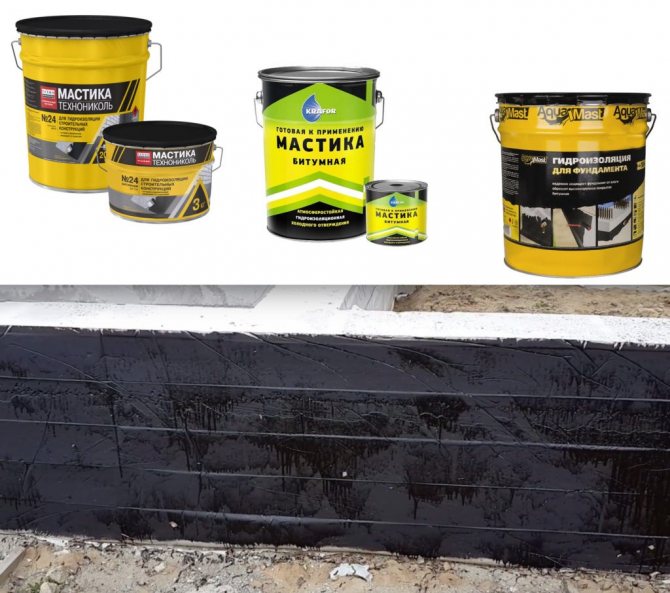
It is better to apply lubricants in two or three layers, applying them one by one, letting each layer dry. First of all, the solution is applied to the joints of the walls and floor, then around the risers and only after that the rest of the surface of the wooden floor is covered
Penetrating
Apply in the same way as mastics. But the main advantage of the materials is their high penetrating power. This is the only technology that allows you to protect the tree from both sides at once.
The disadvantage of materials is their cost. In addition, they appeared on the market quite recently and did not have time to gain popularity. Usually used to protect reinforced concrete structures.
Okleechnaya
Before use, the surface should not only be free of dirt and dust, but also degreased with a mastic or primer. They allow you to increase the adhesion of materials, since in rolls it is quite low, even in spite of the presence of a self-adhesive layer.
They are used for mineral-based structures. Applicable:
- Materials in rolls based on bitumen. Their service life is no more than 5 years.
- Films. They can last a little longer, up to seven years.
- Membrane. They are considered the most durable.
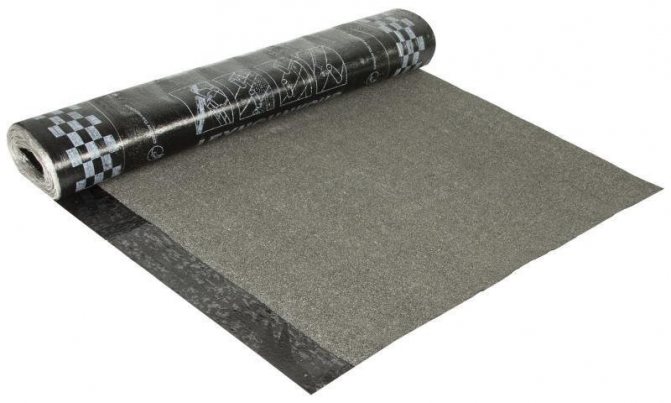

Complex processing, when mastics and gluing materials are applied, allows to extend the service life of the waterproofing up to 20-50 years. But usually the sub floor needs to be repaired much earlier, which should be taken into account.
The advantage of film coverings is that tiles can be laid directly on top of them using only glue. There is no need to prepare the screed.
Impregnations
They consist of fine sand, cement with a water-repellent property, and chemical additives. This allows you to reliably clog the pores of the wood.
The composition forms a protective shell that prevents moisture penetration. But impregnation is not recommended for residential use.
Sprayed
This type of waterproofing allows you to create a smooth, seamless finish for a wooden floor. But to work with the material, special equipment is required. The insulation cures quickly when exposed to air.
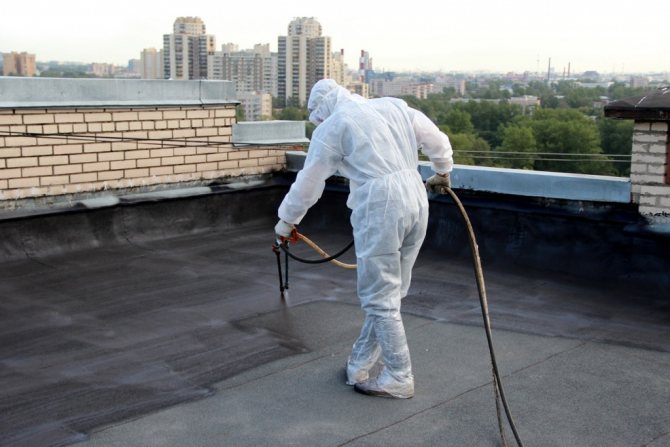

Their use is not beneficial for small spaces. Also, the disadvantages include a high probability of damage. But it is compensated, since the main coating is laid on top.
Types of vapor barrier materials
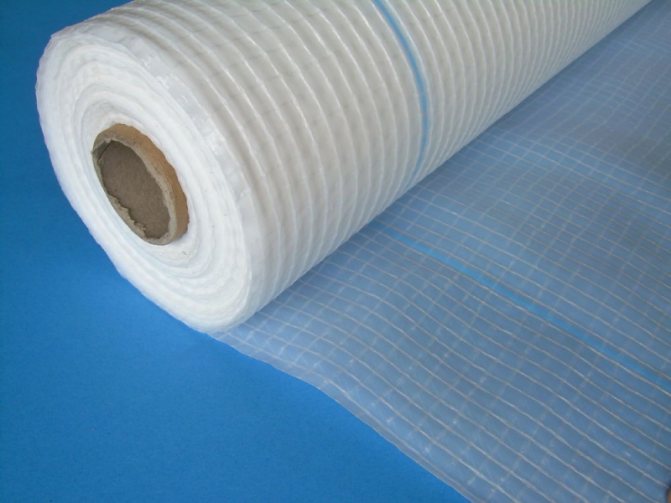

Materials differ in the amount of vapor permeability
There are many different types of insulation materials. Each has its own advantages and disadvantages, so it is important to study all the characteristics and, based on the analysis, choose the most suitable option.
Vapor barrier materials differ in structure and coefficient of diffusion resistance (Sd, m). The value of vapor permeability is relative and depends on temperature and humidity.
The material, which has a diffuse resistance of 0.02 m, forms a resistance to water vapor, like an air layer of 2 cm. A resistance of 0.04 m is the lowest threshold of a membrane with high vapor barrier characteristics.
The indication of the Sd value is a guarantee of the original products of a certain brand.
Polyethylene film
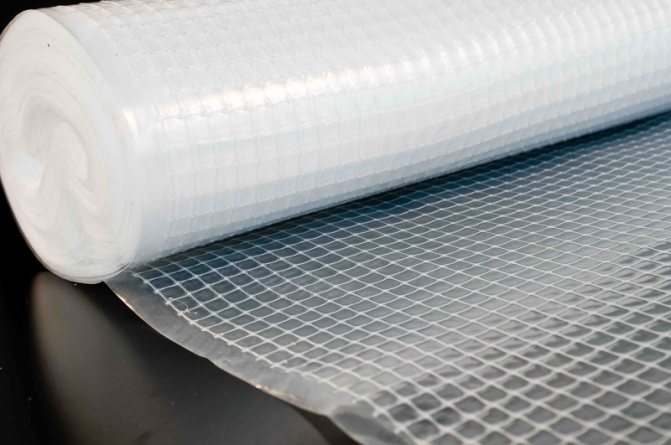

Vapor barrier film reinforced with woven threads
Related article: Embroidered cross-stitch paintings: large cross-stitches, photos, how quickly, video and gallery, drawing on canvas, flowers and frame
The most common and economical option that comes in rolls. To increase the tear resistance, the film is reinforced with fabric threads. The material is produced with and without perforation.
The perforated type has micro-holes in its structure, due to which it has high vapor barrier performance, while it has a diffusion resistance of 1-2 m. It is capable of passing a small amount of steam. Most often used as waterproofing.
Non-perforated films have a resistance index of 40-80 m and are a good barrier to the passage of steam, as well as protect against condensation.
Double-sided film has a smooth surface on one side, and a fleecy on the other. Roughness retains moisture, does not allow condensation to drain onto the insulation. The main disadvantage is that the film does not breathe and tears easily.
Polyethylene with reflective layer
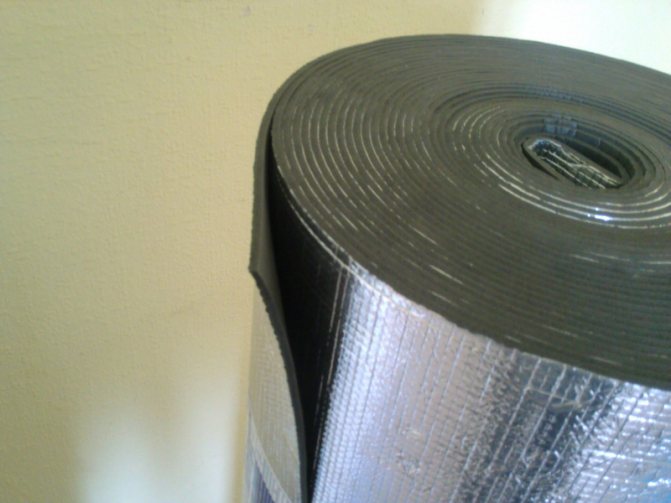

The film with an aluminum layer is most often used in rooms with high humidity: bathrooms, baths, saunas and kitchens.
It is a good barrier to the passage of steam Sd = 200 m.
The aluminum layer reflects infrared rays, thereby retaining heat in the room.
Polypropylene
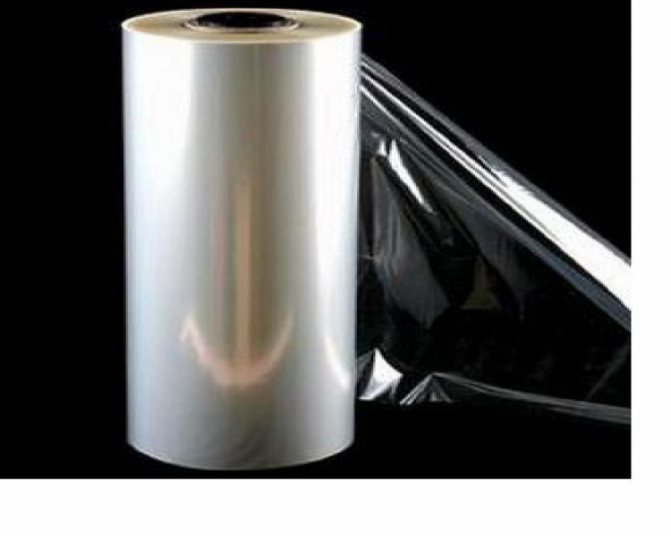

Polypropylene withstands temperature changes well
Polypropylene films have sufficient strength, withstand temperature extremes, and at the same time have a higher cost.
The best quality option is reinforced propylene with a cellulose or viscose insert.It features a slightly loose matte surface that is able to retain a sufficient amount of moisture. Thanks to this layer, the condensate does not flow to the insulation, but gradually evaporates from the surface of the material.
When installing a vapor barrier with an antioxidant layer, leave a small gap for air exchange.
Foil material
The combined two-layer material consists of two layers:
- the base (expanded polystyrene, mineral wool, foamed polyethylene) works as a heater;
- the foil-clad aluminum coating reflects the infrared spectrum and has a high vapor barrier performance.
It is laid with a foil layer in the room. The aluminum coating melts when exposed to high temperatures.
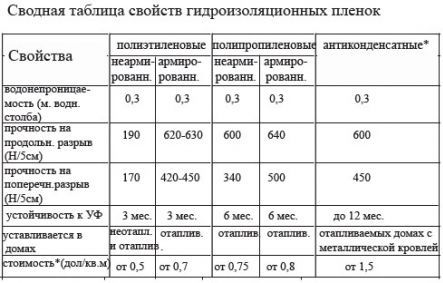

Film properties depending on the structure:
Related article: The final stage of facade work is framing the windows of the house
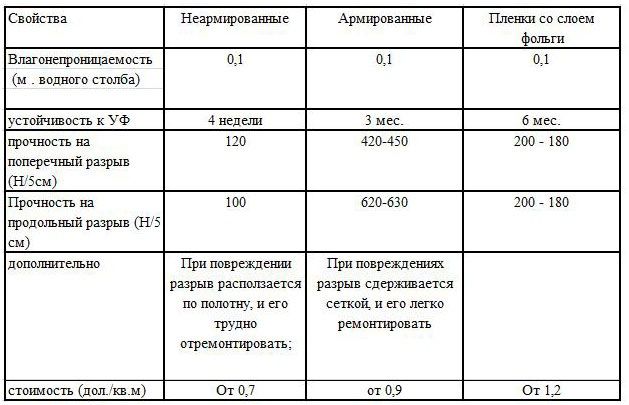

Membrane materials
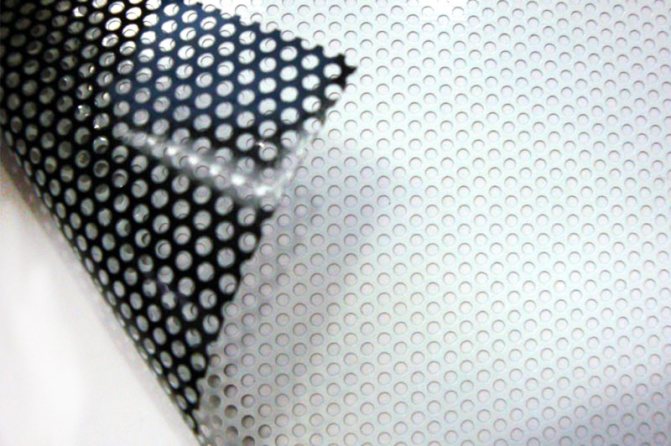

Breathable diffuse membranes are made from artificial fibers.
These are the highest quality, but at the same time, expensive materials.
They have a long service life, high levels of vapor barrier and strength.
Produced:
- one-way types that discharge steam in one direction;
- double-sided are capable of venting steam from both sides.
Each of these types can be single-layer or multi-layer. The more layers, the more moisture the material can retain.
Before laying a one-sided membrane, be sure to follow the instructions, it is important not to confuse which side to lay the material on.
Intelligent membranes
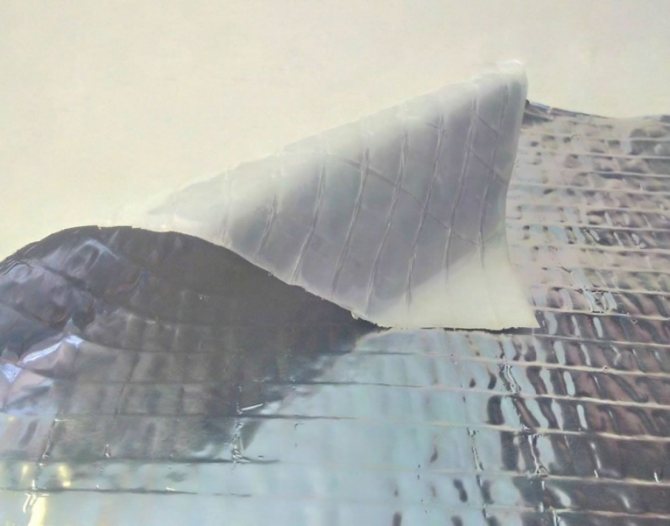

Intelligent membrane materials are capable of regulating humidity and temperature and at the same time perform the function of waterproofing.
They do not require a ventilation gap and are easy to install.
The models have the highest cost, but they justify themselves with a long service life and a combination of several functions.
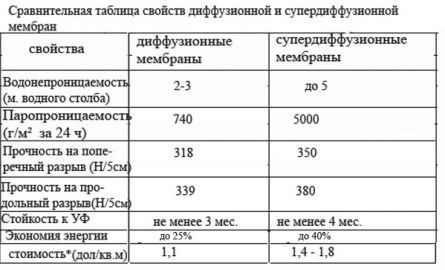

Surface preparation
Before waterproofing a wooden floor, it is important to properly prepare the base. First of all, it should be cleaned of debris, dirt and dust. Then, all the cracks are sealed. For these purposes, mastic is used for woodwork. Lags are treated with an antiseptic solution, then a protective impregnation is applied.
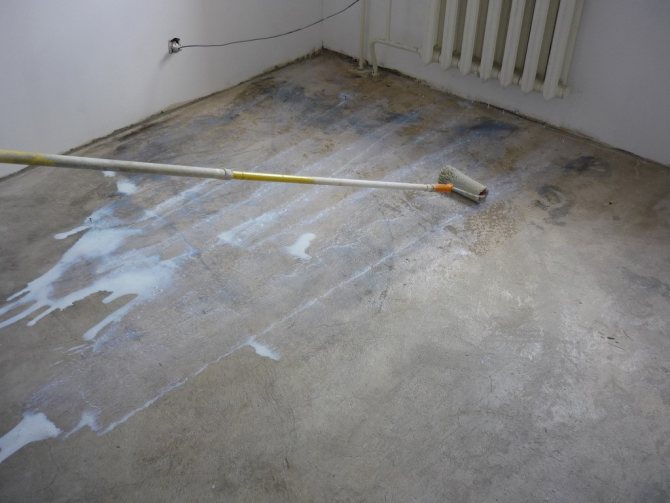

In order to insulate and increase sound insulation between the logs, expanded clay or mineral wool is laid. The choice of insulation depends on the characteristics of the room, financial costs and individual preferences.
Plywood pre-treated with moisture-resistant impregnation is laid on top of the insulation. After fixing on the floor, a waterproofing primer is applied to the sheets. It should dry well enough, and dirt and dust should not get on its surface.
The primer is also applied to the walls, at a height of 25 cm around the entire perimeter. This will protect them from splashing water.
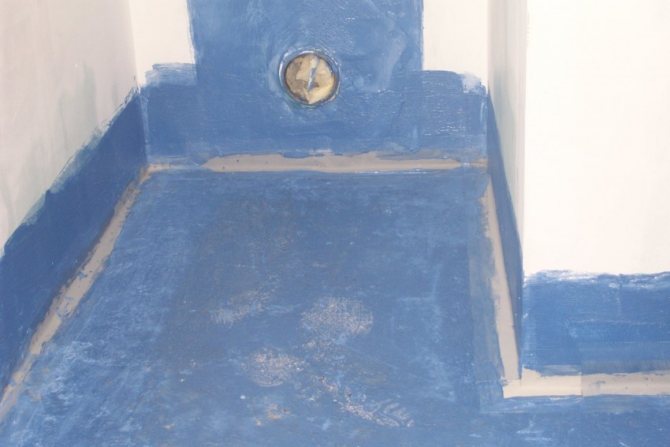

Floor screed waterproofing
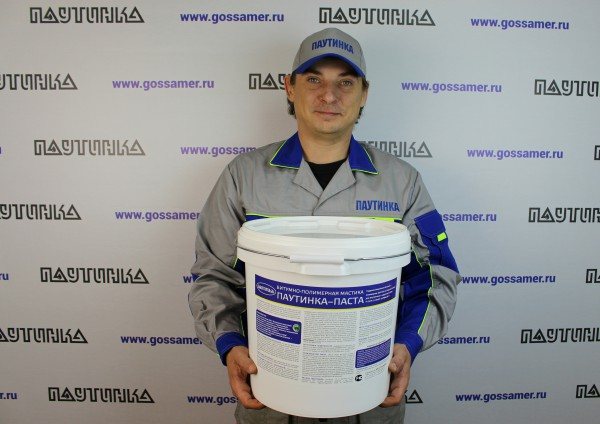

The waterproofing of the floor screed, which lies directly on the ground, is performed in the following sequence: first, we tamp the soil, then we lay a separating layer of geotextile, pour on top and tamp high-quality granite crushed stone 15-20 centimeters thick, then again a separating layer of geotextile. Next comes a layer of sand that will serve as the basis for waterproofing the floor screed. Geotextile plays a separating and at the same time drainage layer in our "pie", that is, moisture will easily pass through it, but geotextiles will not allow the upper and lower layers, which it separates, to mix with each other. Sand and crushed stone separated by geotextiles will not mix over time and the soil under the floor will not sag. Sand and crushed stone are not hygroscopic substances, that is, water cannot rise along them from bottom to top under the waterproofing of the floor screed.In addition, it is advisable to provide a drainage system and a device for shut-off waterproofing of the foundation walls. Further, it all depends on what material we will use for waterproofing the floor screed.
Wooden floor waterproofing process
Waterproofing a wooden floor is carried out in several stages. Their sequence should be carefully followed and each step should be followed correctly.
| Apply mastic, based on bitumen, on the wooden floor, walls to a height of 20-25 centimeters. To perform the work, use a roller or brush (special brush). After 4-6 hours after applying the first layer, apply the second one. In this case, the roller must be moved in the opposite direction. In the process of drying the solution, it is necessary to exclude the ingress of dust and dirt on it. |
| Cut the roll material into strips. Their length should be equal to the distance from wall to wall. In this case, it is necessary to take into account the approach to the walls (add 40-50 centimeters). |
| Roll material from both ends towards the middle. There should be two rollers. |
| Unroll one roller gradually. Put mastic on the base in front of him. The material is fixed with a special roller. The second side is laid in the same way. This is necessary so that voids do not form between the surfaces. |
| When using a self-adhesive waterproofing material, remove the film as it rolls out. It can be removed easily and effortlessly. |
| Subsequent canvases are laid in a similar pattern. In this case, one edge of the previous one should overlap at a distance of 10-15 centimeters. The junction is coated with mastic between the materials and from above. This improves adhesion and waterproofing properties. When using thermoplastic materials, a special welding machine is used for these purposes. But before using it, it is important to conduct tests on the trims in order to find the best temperature regime and heating time. The result can be verified using a tensile test. The material should not diverge at the seam. |
| All corners must be glued with roll material, from which strips are pre-cut. Their width can vary between 30-35 centimeters. The edge is laid on the floor, and the rest is brought onto the wall, carefully gluing. |
After the work is done, you can start thinking about the appropriate finish coat option.
Work on waterproofing a wooden one takes a lot of time and effort. But its correct and high-quality implementation will increase the service life of the subfloor and topcoat by 20-50 years and avoid the need for expensive repairs or replacement of wooden logs.
Do-it-yourself floor vapor barrier
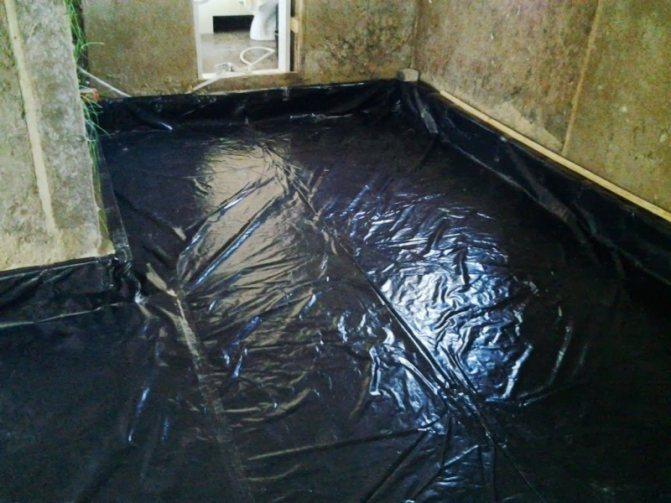

In a wooden house, the floor is equipped with several layers:
- An air gap remains between the soil and the subfloor. The underfloor is self-ventilated.
- Lags are made from thick timber.
- Laying waterproofing, insulation, vapor barrier.
The best option is to install insulation during the construction phase. In this case, less labor costs. It happens that during operation or repair it is necessary to lay the floor waterproofing. For information on how to put a vapor barrier when installing a sub-floor, see this video:
Preparatory work
When building a house, we treat all wooden materials with antibacterial compounds against fungal infections and pests.
Subfloor boards and logs are most susceptible to moisture.
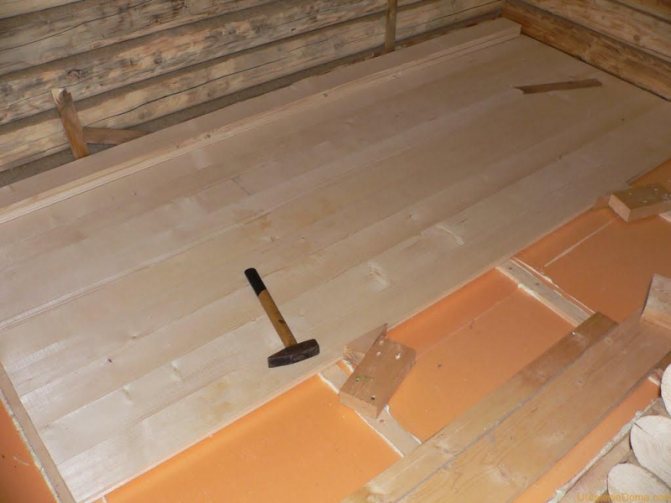

We put a vapor barrier layer on the rough boards and put thermal insulation on it.
If the vapor barrier needs to be installed during operation, we disassemble the floor to the rough boards. We check the condition of the floorboards. We replace the deformed boards damaged by mold or pests. We treat the logs and the first layer of the floor with protective compounds.
Insulation laying
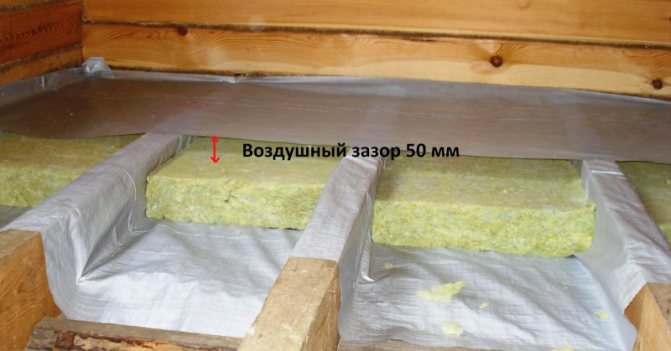

Laying the vapor barrier material is easy to do with your own hands. To do this, you need to follow the installation instructions for the selected material and know the sequence of actions.
Related article: Professionals advise: choosing short tulles and curtains
Stages of laying a vapor barrier layer:
- Spread the selected insulating material on the subfloor floorboards so that it lies freely. The strips should overlap by 150 mm. Models can be mounted on galvanized nails, staples, adhesive tape. We glue the joints with double-sided tape.
- We mount the logs strictly in the horizontal plane.
- We install thermal insulation (mineral wool, expanded polystyrene, polystyrene). We make sure that there are no gaps between the logs and the insulation. If, nevertheless, a space has formed, we fill it with polyurethane foam.
- We put a layer of vapor barrier material on the insulation, it will be an obstacle to the penetration of steam from the room. We lay the film so that there is a small ventilation gap. No gap is required when laying the membrane.
- We mount boards with a 2 cm gap between the vapor barrier and the floorboard.
- We lay the topcoat.
When laying the vapor barrier material, it is important to lay it on the correct side.
Professional advice
Waterproofing a house is a job that requires not only financial investment and time, but also accuracy.
Professionals recommend:
- Do not use flammable materials.
- Leave a ventilation gap between the subfloor and finish floor. This will reduce the likelihood of condensation, mold and fungal infections.
- When choosing a material for waterproofing a wooden floor, you should take into account the presence of a basement, subfloor, type of insulation, moisture level and the material from which the subfloor is made.

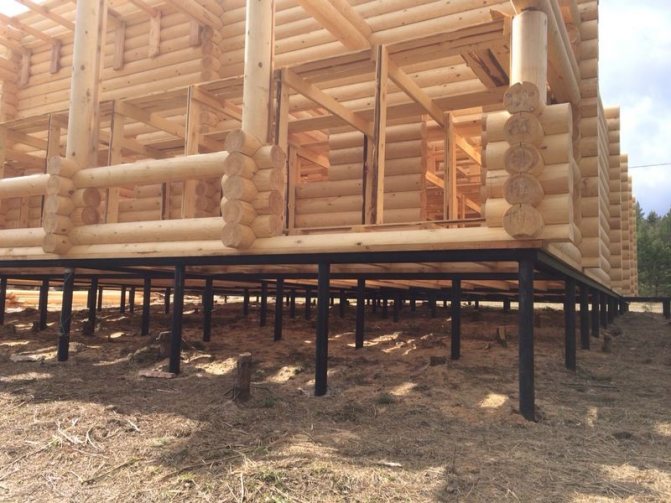
- Be sure to treat the tree with an antiseptic solution.
- When working, use personal protective equipment, since many solutions have a pungent or unpleasant odor, which can cause a headache.
- Each layer of solutions should dry well before applying the second.
Experts recommend following the sequence of work. But there are times when there are slots on the floor that are approximately the same in width. They form when wet boards are applied. This is not allowed during construction, but such a violation often takes place. Deck floors can be used to remedy this situation.
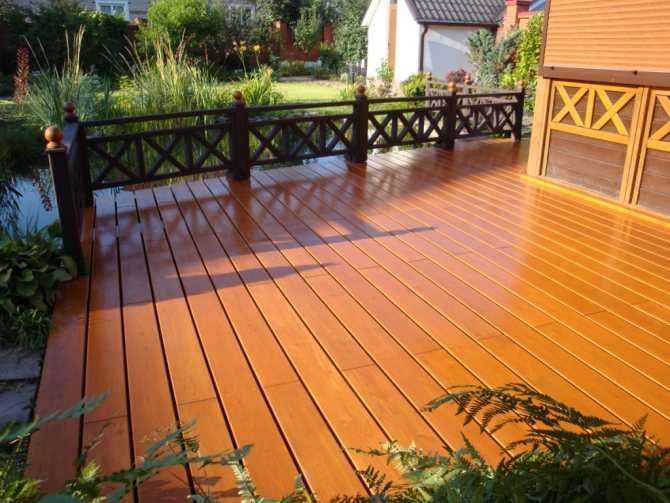

They have dark stripes between the boards, and with the help of modern materials, it is possible not only to waterproof, but also to create a unique design coating.

